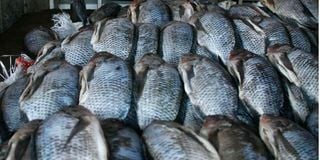Fish harvested from Lake Nakuru not fit for human consumption: Report

The researchers, in their findings, noted that Nile tilapia harvested from Lake Nakuru was not safe for human consumption.
Fish harvested from Lake Nakuru is still not fit for human consumption, according to an October 2022 revised report by four researchers.
Nine composite water and nine sediment samples, as well as 30 fish specimens, were collected from five representative sampling sites within Lake Nakuru in research done by Mary Florence Nantongo, Joseph Edebe, Elick Otachi and Julius Kipkemboi.
Despite the documented report, the prohibited species are still flooding several fish markets within the country, putting at risk the lives of consumers.
In an exclusive interview with the Nation, Lake Naivasha Patrol Network Chairperson, Grace Nyambura, admitted that the sale of the fish is still rampant.
“Truth be told. The sale of the fish is still ongoing despite the concerns by researchers. The enforcing agencies should rein on those perpetrating the illegal business,” she added.
Ms Nyambura who is also the Lake Naivasha and Oloiden fishers community based organisation chairperson, lamented that the harvested fish has also affected business among fish operators in Naivasha.
The seasoned fish operator called for concerted efforts to arrest the vice, saying the concerns by researchers was a “wake up call” for the relevant authorities.
The study was conducted to assess the levels of selected organochlorine pesticide (OCP) residues in water, sediments and Nile tilapia, as well as the potential health risks to humans who consume the fish of Lake Nakuru.
The researchers, in their findings, noted that Nile tilapia harvested from Lake Nakuru was not safe for human consumption, recommending that policy makers implement mitigation measures.
“Policymakers should come up with an environmental monitoring programme and mitigation measures for reducing pollutant inputs into the Lake, thereby managing water quality status,” reads the report.
Responding to the concerns, Nakuru county Chief Officer, Environment, Ken Barasa said it was “Environmentally very difficult” to arrest toxins flowing into the lake due to the position of the natural resource.
Also read: Fresh warning against fishing with chemicals
“Industrial waste and metals washed away from uncontrolled garages will finally, in one or another, find their way into the lake ecosystem,” he observed
He too admitted that fish from the Lake is not fit for human consumption, adding that consumption of wildlife within protected areas is prohibited by law
The findings indicate that most organochlorine pesticides, though banned in Kenya, are still detected in the environment, posing potential long term health hazards to humans.
“Accordingly, an environmental monitoring programme and mitigation strategies of reducing pollutant inputs into the lake is recommended, as well as an immediate ban on harvesting and consumption of fish from Lake Nakuru,” noted the researchers.
The study result obtained for OCP concentrations in water indicated that cyclodienes have recently been used in the lake Nakuru catchment.
Lake Nakuru is a shallow endorheic lake located in the Eastern arm of the Rift Valley. It is a regular-shaped basin with gentle slopes and a nearly flat bottom
The report details that the natural resource is located in Nakuru County, south of the town of Nakuru, approximately, lake has a surface area of 70 m2 and a total catchment area of 1800 m2.
The lake catchment is bordered by Menengai crater in the North. Between the lake and the crater is the town of Nakuru, Bahati highlands in the Northeast, Mau escarpment in the West, Eburru crater to the South and grasslands between Nakuru and Elementeita in the East.
Prior to its recent limnological changes, Lake Nakuru was famous for providing habitat to one of the largest populations of lesser flamingos.





